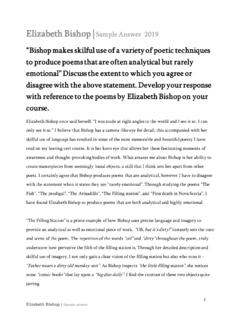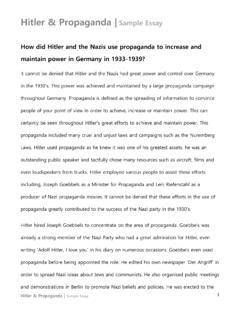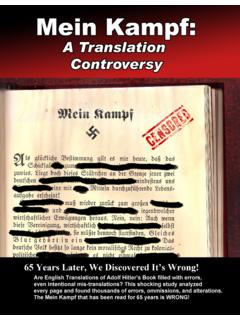Transcription of How did church-state relations develop under Hitler and ...
1 Dictatorship and Democracy, 1920-1945 |. Sample answer How did church-state relations develop under Hitler and Mussolini? (2014). Both Hitler and Mussolini were not religious men. However, in both Italy and Germany, the Church was seen as a source of huge power, with wide influence. While Mussolini liked to portray himself as a totalitarian dictator, he actually relied heavily on the support of wealthy industrialists and the monarchy to maintain his power. Mussolini sought to improve relations with the Vatican to make his dictatorship more acceptable to Italy's predominantly Catholic population.
2 While in Germany, the Nazi's took inspiration from the Christians practices for their own quasi-religious ceremonies, but they believed that Nazism should one day replace Christianity as the predominant faith of the Aryan people. In this essay, I will look at the positive and the negative developments in church-state relations under Mussolini and Hitler 's rule. Mussolini did not believe in God, he was strongly opposed to the Catholic Church but moderated his views. While Mussolini governed the political side of Italy, the Roman Catholic Church governed the spiritual side and so realised he would have to improve his relations with the church in order to get the support of the entire nation.
3 So he made a number of gestures to improve these relations , such as baptising his seven children in 1923 and getting married in 1925 after 10 years of being with his partner. One of the reasons why Mussolini pushed the idea that women should stay at home and look after the family while their husbands worked, was because this was an idea pushed by the Roman Catholic Church. Mussolini voiced his disapproval at the use of contraception, much to the praise of the Roman Catholic Church. Like the Catholic Church, Mussolini also wanted divorce and abortion banned in Italy.
4 By his action, Dictatorship and Democracy, 1920-1945 | Sample answer Mussolini was gaining support from the Roman Catholic Church and in turn gaining credibility to his government. However, his relationship was not always harmonious with the church. In particular, Mussolini and the Roman Catholic Church clashed over who should control education. To ensure that children grew up as good Fascists, Mussolini wanted the state to control schools. However, the Roman Catholic Church felt that it should have this power. Both sides worked for a compromise.
5 This agreement can be seen in the Lateran treaty in 1929. under the terms of the treaty, Mussolini and the papacy agreed that Catholicism would become the state religion and the Vatican was to be an independent sovereign state. The Italian state agreed to compensate the papacy for the loss of the Papal states in 1870 with a payment of 30 million. Priests could not join a political party and the Pope was forbidden from interfering in international disputes. This treaty was a huge success as it brought a 60-year-old between the Roman Catholic Church and the Italian state to an end and brought Mussolini's regime much prestige both at home and abroad.
6 However, the Vatican's relationship with Mussolini's government deteriorated drastically after 1930, when the Fascists began to limit the freedom of the Church. Such as their attempt to merge the Church's youth groups into the Balilla. Pope Pius responded by issuing an encyclical We Have No Need' in 1931. It denounced the attacks on the Church in Italy and condemned pagan worship of the state'. In 1936, the Pope condemned Italy's invasion of Abyssinia. Mussolini's adoption of Nazi-style race laws in 1938 was furiously rejected by the Vatican.
7 The Church worked to try and protect the Jews from the Fascist party in Italy throughout this time. The Vatican remained an independent body throughout Mussolini's dictatorship and continued to act as the authoritative voice of the Catholic population. It was too powerful in Italian society for Mussolini to actively suppress. Dictatorship and Democracy, 1920-1945 | Sample answer The relationship between the Catholic Church and the hierarchy in Nazi Germany was fraught with difficulties. It had seemingly started well after Hitler was appointed Chancellor on January 1933.
8 However, the breakdown in their relations started in 1936. In July 1933, just six months after Hitler was appointed Chancellor, the Catholic Church signed the Concordat with Hitler . As a result of this agreement, the Catholic Church agreed not to engage in political activity and agreed to take an oath of loyalty to Hitler . Pope Pius XI hoped that the Concordat would allow the Catholic Church in Germany to operate free from any interference. However, he was soon to be disappointed. The Nazi's quickly began to interfere in Catholic affairs, particularly in relation to education and youth groups.
9 Members of Hitler Youth intimidated and spied on members of youth bible study groups. Parents were pressured to withdraw their children from Catholic schools and place them in Nazi-approved schools. In 1937, Pope Pius XI issued an encyclical With Burning Anguish', which denounced the Nazi's for breaking the terms of the 1933. Concordat. Priests in Germany were warned not to criticise Hitler or the Nazi regime. However, individual priests did make a stand against the government and between 1939 and 1943, 693 Catholic priests were arrested and tried for oppositional activity.
10 The most open protest was carried out by Bishop Von Galen in 1941. He denounced the policy of forced euthanasia' of the mentally and physically disabled. He also attempted to bring a lawsuit against those he deemed responsible. Galen called on all German Catholics to give immediate protection to the mentally ill to save them. He condemned the authorities for labelling these people as unproductive national comrades . A government minister called on an order for his execution, but Goebbels objected stated that only Hitler could order such an outcome.

















